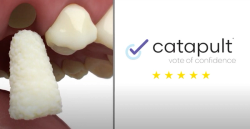- About Us
- Advertise
- Editorial
- Contact Us
- Terms and Conditions
- Privacy Policy
- Do Not Sell My Personal Information
© 2025 MJH Life Sciences™ and Dental Products Report. All rights reserved.
How to esthetically match surrounding tooth structure with a single shade
Why one clinician enjoyed using OMNICHROMA to restore a compromised posterior tooth.
A common nightmare clinicians face every day has to do with shade selection of the materials we use in our patients’ mouths.
For most of us, gone are the days of silver amalgam fillings and gold crowns; our patients want natural-looking teeth. Natural today is relative to how many times they’ve bleached their teeth. This shade selection anxiety goes up when working in the well-lit and highly visible anterior smile zone.
Dr. Israel Abramov, of the City University of New York, has found that women are better able to discern hues and subtle color differences; therefore, I often rely on my female team members to confirm the color choices of the material we use. In my 30-plus years in practice, I’ve just accepted that I’d have to choose colors for the rest of my career, and one of my dreams would be to not have to worry about the color of the composite restorative materials I place.
Then, I was approached by Tokuyama Dental America to try its newest material, OMNICHROMA, a one-shade composite that it said would adapt to match the color of the surrounding tooth. Indeed, when I was told the company had a new material where one shade would be appropriate for almost every direct composite restorative need, I was very skeptical. Could a dream come true?
Tokuyama Dental has developed a composite material based on the concept of “wide color matching.” The company has created a single material that can cover a wide range of natural tooth colors.
This means savings with less time spent anguishing over composite shades as well as the monetary and space savings from not having to inventory so many different shades, each in varying degrees of opacity. After years of research and development, Tokuyama Dental has developed the very impressive OMNICHROMA composite, which can tout the simplest shade system I know of.
Related reading: A game-changing dental composite
OMNICHROMA is a single-shade, structurally-colored universal composite. The single-shade OMNICHROMA has the ability to esthetically match the 16 classical VITA shades with Tokuyama Dental’s Smart Chromatic Technology, achieved using uniformly-sized 260 nm spherical fillers.
OMNICHROMA’s spherical fillers work as an additive color mixing system, which is different from most composites that use the subtractive color mixing system of pigments and dyes.
The subtractive color mixing system requires us to select a shade matching the tooth because the material color is established by pigmentation. Using the additive color mixing system, OMNICHROMA generates a red-to-yellow structural color equivalent to the surrounding natural tooth.
Sounds good, but we also know a tooth has many different opacities that make up its color. Typically, the dentin is more opaque than the more translucent enamel. The translucency of the enamel gives us a natural depth.
So, with most composite materials, we load up with the more opaque dentin shades, the more translucent esthetic enamel shades, perhaps a universal shade and others. Again, OMNICHROMA fills all these shoes, but with a caveat.
When doing a large Class III or IV restoration, the darkness of the oral cavity would make the restoration have the appearance of having a lower value (value is the relative lightness or darkness of a color). With the OMNICHROMA system, there’s OMNICHROMA BLOCKER to use as a lingual layer to maintain the higher value of large anterior restorations or to mask slight staining, unlike with most composite systems.
OMNICHROMA is appropriate for use in both the anterior and posterior teeth. The patient in this case report needed an occlusion amalgam replaced on a posterior tooth, and we elected to use OMNICHROMA as the restorative material to demonstrate its working qualities.
Continue reading on page two...
Step-by-step case
Step 1: One carpule of 1.8 cc 2% lidocaine 1:100,000 epi was administered.
Step 2: The tooth was isolated with a rubber dam (Fig. 1).
Fig. 1
Step 3: No time was taken to select the shade because we were using OMNICHROMA.
Step 4: The tooth had areas of interproximal decay and the distal-lingual cusp was compromised. The amalgam restoration, decay and weak areas of the tooth were removed. The occlusal margins were beveled to improve the bond and color (Fig. 2).
Fig. 2
Step 5: Seek™, a caries indicator from Ultradent, was used to ensure there was no decay left behind (Fig. 3).
Step 6: The tooth was then air abraded with Danville Material’s MicroEtcher™ CD, a 27-micron aluminum oxide abrasive (Fig. 4).
Fig. 3 Fig. 4
Step 7: The Triodent® V3 Sectional Matrix system was used to create the distal contact (Fig. 5).
Step 8: The tooth was selectively etched with Clinician’s Choice’s Max Etch, a 35% phosphoric acid. The etchant was placed on the enamel margin trying to avoid any significant phosphoric acid etching of the dentin (Fig. 6).
Fig. 5 Fig. 6
Step 9: The etchant was then rinsed off the tooth thoroughly and the dentin area of the tooth was kept moist. Clinician’s Choice G5 was scrubbed into the tooth for its antimicrobial, desensitizing properties (Fig. 7).
Step 10: Tokuyama Universal Bond from Tokuyama Dental America was placed on the tooth. Tokuyama Universal Bond is a two-bottle system that’s mixed in a well, and then the mixed bond is applied to the tooth (Fig. 8).
Fig. 7 Fig. 8
Step 11: A weak air stream was applied to the surface until Tokuyama Universal Bond stops moving, and then a mild air stream is used. There’s no need to light-cure the bond before placing the OMNICHROMA composite material. Using Tokuyama Universal Bond saves chair time and negates the concern about curing light shadowing (Fig. 9).
Step 12: A small amount of Estelite Universal Flow from Tokuyama Dental America flowable composite in Medium Flow was placed on the bottom of the preparation to ensure complete adaptation (Fig. 10).
Fig. 9 Fig. 10
Step 13: OMNICHROMA BLOCKER, which is more opaque, was placed where the tooth was darker on the preparation floor (Fig. 11). Then, OMNICHROMA composite was placed incrementally.
Step 14: Using composite instruments, such as Dr. Ronald Jordan’s, allows me to work with the composite materials without sticking (Fig. 12). It should be noted that even when exposed to ambient light, OMNICHROMA had sufficient working time, allowing for its ideal contouring. Before it is cured, OMNICHROMA will typically appear more opaque and white than the surrounding tooth structure but will blend in, becoming semi-translucent, when it’s cured.
Fig. 11 Fig. 12
Step 15: Each increment of composite was cured with Ultradent’s VALO™ Grand curing light (Fig. 13). Complete curing is critical when working with any light-cured composite material.
Fig. 13
Step 16: Once the preparation was completely filled, the occlusal surface was polished with Clinician’s Choice’s A.S.A.P. polishers.
Tokuyama Dental has long been known for its high-quality and highly esthetic composites, and OMNICHROMA is an example of this lineage of high-performance composites, such as Estelite Sigma Quick. This case demonstrates that OMNICHROMA excels in many areas. It handles very well, and the single shade has excellent esthetics with the surrounding tooth structure. Polishability is easily achieved, and both patient and clinician were pleased with the results after restoring a very compromised tooth (Fig. 14).
Fig. 14

 Download Issue: Dental Products Report September 2019
Download Issue: Dental Products Report September 2019

